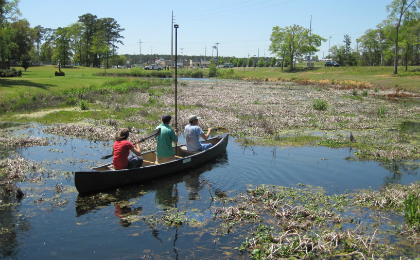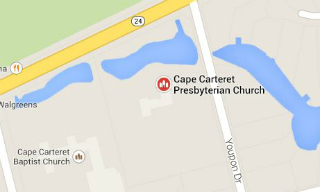 The stormwater ponds of two churches in Cape Carteret — the Presbyterian church, pictured left, and Baptist church, right — will soon get a makeover, thanks to the N.C. Coastal Federation. Photo: Google Maps |
Reprinted from the Tideland News of Swansboro.
CAPE CARTERET — The designs are completed, the easements surveyed and soon the N.C. Coastal Federation will file for necessary state and federal permits for the long-awaited improvements at two stormwater ponds in Cape Carteret that have been eyesores in recent years.
Supporter Spotlight
Lexia Weaver, a coastal scientist for the federation, said she hopes the work to turn the Cape Carteret Baptist and Presbyterian churches’ ponds into functioning wetlands can begin before the end of this year. That, she said, will depend on the permitting process.
The project, on which the federation expects to spend about $300,000, will not only improve the aesthetics of the area – right off N.C. 24 in the heart of Cape Carteret in western Carteret County – but also should improve water quality in Deer Creek, which gets the stormwater runoff that the ponds hold That runoff comes from adjacent properties, from N.C. 24 and from the commercial development, including a Lowes grocery store and Lowes Home Improvement store on the other side of the highway.
 N.C. Coastal Federation staff examines one of the churches’ stormwater ponds in a canoe. The pond is overgrown with vegetation. However, the new design will create a tidal salt marsh that’s higher salinity level will likely kill off the invasive plant species. |
“We’re excited that we’re almost ready to start,” Weaver said. “We’ll be meeting with the church leaders and the town officials in the next couple of weeks to make sure they know exactly what’s going to happen. And we’re in the process of setting up a meeting with the agencies to learn exactly how we need to proceed.”
Permits will be required from the Army Corps of Engineers, the N.C. Division of Coastal Management and the N.C. Division of Water Resources.
Cape Carteret commissioners, during their meeting on Sept. 9, said they are eager to see the project started. Mayor Dave Fowler appointed building inspector Brandon Hawks, town attorney Mike Curtis and commissioner Eddie Seegers to serve on the committee to meet with the federation, church and state officials for that pre-application session on the site.
Weaver said the design for the project is innovative and will be aesthetically pleasant. The stormwater will first enter the smaller, upper pond on the Baptist property. This pond will be reconstructed to have sand and rock layers below the planted vegetation and will serve as a bio-retention area, filtering as much of the pollutants as possible from the collected storm water.
Supporter Spotlight
The water that remains will flow to the larger basin on the Presbyterian property. And the real innovation, Weaver said, is that this part of the system will be a tidal salt marsh.
“When we took the elevations we were somewhat surprised that it was not far from the elevation needed for a salt marsh,” she said. “We found out that if we dig just a little bit deeper, it can be a salt marsh, so that’s what we’ll do.”
Salt water will flow back and forth with the tide. The salt level will be high enough, Weaver said, to kill off invasive plant species and keep new ones from taking hold.
One of the major fears of some church officials, Weaver said, is that the wetlands vegetation would be so tall that motorists’ views of the churches would be obscured. The salty nature of the wetland will ensure that doesn’t happen, she said.
 This map shows the two stormwater ponds next to Hwy 24 and their close proximity to Deer Creek, far right, which flows into Bogue Sound and eventually the ocean. The ponds help contain polluted stormwater runoff from the surrounding roads and commercial properties from reaching coastal waters and degrading water quality. Map: Google |
A conservation easement allows the churches to install benches, walkways, bridges, plantings and other amenities that would make the pond areas suitable for worship and other passive uses, but still maintain the former pond sites as natural areas.
Longstanding problems with the ponds were exacerbated in November 2012 when a water control structure failed and the water drained into Deer Creek. Cape Carteret officials contacted the federation to see what could be done, and the organization suggested that the ponds be turned into wetlands.
The then state Division of Water Quality had surveyed the larger pond but said it didn’t have the money to help restore it. The state DOT also declined to help, despite having four pipes that bring water into the pond from N.C. 24. The Army Corps of Engineers said that the pond predated its permitting process, but if the Corps become involved in fixing the pond, a permit would be needed before any work is done.
At one point, all involved envisioned seeking a 60 to 40 percent state grant, meaning the two churches would each have to supply 20 percent of the project bill. The town agreed to act as a fiscal agent for the grant but would assume no fiscal responsibility or liability for the project itself. The churches’ costs were expected to be $20,000 to $25,000 each, and a total cost of $200,000 or so was envisioned.
The church balked at the high cost.
Then the federation closed on the sale of an easement at its massive North River Farms wetlands project and earned $3 million. Federation executive director Todd Miller thought cleaning up the ponds would be a neighborly – and environmentally significant – thing to do.








